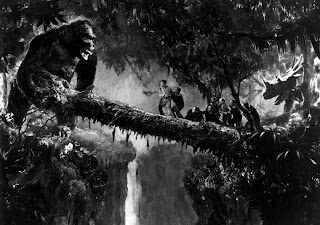Director: Merian C. Cooper, Ernest B. Schoedsack
Producer: Merian C. Cooper, Ernest B. Schoedsack
Cast: Fay Wray, Robert Armstrong, Bruce Cabot
Year: 1933
'One of the finest adventure movies ever made, and the true prototype for all monster movies to follow, KING KONG is, even after 83 years, still the one true ruler of high-end escapist cinema, and I'm absolutely among those who think it's one of the best movies ever made.'
King Kong, labelled as a 'classic', was honored as a landmark of special effects in filming. Apart from a remarkable film of the beginning of the twentieth century, its outstanding visualisations for its time and a pinnacle of stop motion animation, King Kong is considered as a reflector of Americas 1930's society and attitude. Its various sexual and racial issues of that time are strongly expressed within the film.
One of them is how women were thought to be inferior to men. This perception towards the female sex is obvious when Ann, the main character of the story, is on the ship on the way to the tropical island,where the captain thinks it's strange for a female to be on a ship. Female sexuality is also displayed very strongly in the scene where the giant ape touches the woman, taking off her clothes and then sniffing its fingers.
Whereas Ann represents all women of that time, King Kong, depicted as a huge black gorilla represents evil in comparison to a white woman, a symbol of beauty and good. This shows America's existing racism towards black people of that time which is, unfortunately, still noticeable in a lot of countries today.
In terms of its visual effects now, the film takes place into a tropical jungle, a very popular adventure destination for that time, packed with monstrous animals and richness in breathtaking sceneries of nature even though the film is in black and white. Most of the props were handmade miniatures along with the model of the giant gorilla which ironically was of course a lot smaller than it was actually shown in the film. Of course the animation inspired a lot in the film and gaming industry: 'Discussion of King Kong’s revolutionary visual effects generally track back to Willis OBrien’s stop motion effects, and they should. They sparked an era of incredible animation that lasted well into the 1990s when computer graphics began to take their hold on movie audiences.'
The most memorable scene is of course where the giant ape finds itself fighting with planes attacking it on the top of the Empire State Building. It is rather bittersweet when King Kong finally dies falling off the building in the final scene as there is some kind of empathy created towards the animal from the audience.
SOURCES:
http://www.doblu.com/2010/09/30/king-kong-1933-review/
http://www.joblo.com/digital/dvd_review.php?id=1035





No comments:
Post a Comment